I start out with a couple web links I found, showing Epimedium in the wild in China. This particular site has 5 species listed; I'm featuring two of their links. The first is to Epimedium brevicornu, with some nice photos:
E. brevicornu:
http://www.gaolongxiao.com/chinese/product/product_view.asp?productid=1083
Next is E. grandiflorum:
http://www.gaolongxiao.com/chinese/product/product_view.asp?productid=1086
The site also shows a plant listed as E. pubigerum, but the photos themselves have watermark captions as Epimedium hunanense, yet the photo depict neither species! Looks more like the starry white flowers of E. stellulatum or pubescens (my guess is, it resulted from confusion between the similar names of pubigerum and pubescens. The moral is, doesn't trust everything found on the internet; lots of bogus misinformation out there.

Comments
Mark McDonough
Re: Epimedium 2012
Sun, 04/22/2012 - 4:18pmSo many eppies, so little time ;)
Epimedium x 'Domino' - one of the most exciting hybrids in recent years, terrific flower power, great foliage, upright mounding habit. The flowers look peachy white at first, but will deepen as they age.
Epimedium grandiflorum 'Tama No Genpei' - a really good one, with large starry bicolored lavender pink and white blooms, and dark purplish foliage, particularly when first emerging. The leaves in front are Asarum canadense.
Hybrids from 'Tama No Genpei' are nice, here's an smallish clumping one with angled upright stems of similar color flowers.
Epimedium stellulatum is a spectacle in the spring garden, the new foliage rising about the evergreen leaves is lime green flamboyantly mottled orange, and clouds of starry white yellow-centered blooms. Several garden views.
Two views of an Epimedium sempervirens hybrid that I have selected. It it noteworthy on several counts, it forms a large rounded clump, the early foliage is dramatically dark purplish brown turning a lighter coffee tone, eventually green, and flowers, while pale, presented above the foliage. Autumn color is deep mahogany.
Richard T. Rodich
Re: Epimedium 2012
Tue, 04/24/2012 - 8:29pmJust a nice pic of a seedling epimedium:
And a species, supposedly
E. platypetalumthat originally came from Chen Yi:(Mark has tentatively identified it as a form of E. sempervirens.)
Trond Hoy
Re: Epimedium 2012
Wed, 04/25/2012 - 3:58amA very nice seedling, Rick!
I don't mention your plants Mark, as I have lost words a long time ago ;)
BTW, does anybody know what kind of Epimedium that grows in the woods of Madeira? I remember seeing a lot of it (think it was only one kind) in the understory there. Don't know whether it is native or foreign though.
Mark McDonough
Re: Epimedium 2012
Fri, 04/27/2012 - 6:21pmThat's the good thing about epimediums, there's hardly ever a seed-grown one that isn't a pleasant plant that's worth growing :)
The Chen Yi plant certainly is not E. platypetalum, a yellow spurless species. Your plant looks like a form of E. sempervirens, based on the incurved spur form. I'm going top order this species again from Garden Vision Epimediums, as mine perished in the drought of 2010.
Richard T. Rodich
Re: Epimedium 2012
Sat, 04/28/2012 - 7:32amI had hoped someone would pipe up with a well educated guess.
Thanks, Mark.
gerrit (not verified)
Re: Epimedium 2012
Sat, 04/28/2012 - 9:48am#1 and #2.Epimedium stellulatum 'Long leaf form'
#3 and #4.Epimedium x youngianum 'Beni-Kujaku'.
ErnieC123 (not verified)
Re: Epimedium 2012
Sat, 04/28/2012 - 10:01amI like all the pictures you have made!
Here a some pictures from my Epimedium, i hope you also like them.
First picture is from E. acuminatum
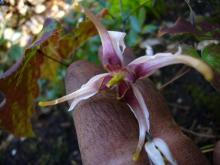
This is E. 'Akebono'
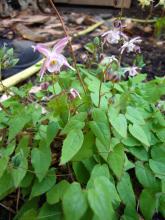
E.fargesii 'Pink Constellation'
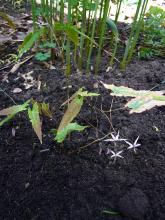
Close-up from 'Fire Dragon'
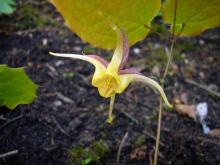
A type of E.grdfl.ssp.koreanum ???
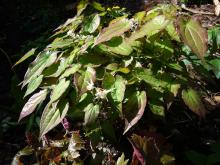
An other type of E.grdfl.ssp.koreanum ??? (big flowers)
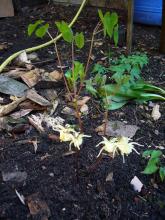
E.grdfl. 'Creeping Yellow'
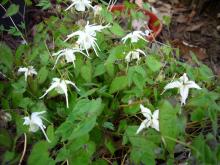
E.myrianthum (this leaves let me dream of an perfect cultivar)
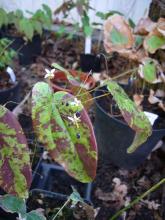
E.grdfl.var.higoene 'Bandit' (It grows quiet well , Hoy)
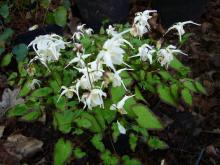
E.pauciflorum
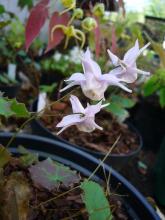
And now i want to say something about E.pallidum! I ask somebody about this mystery plantname.
Breader is Mr.Pagels (Germany) and it should be different to E.versicolor 'Sulphureum' and may be a seedling of that!
I don't know quiet well, but i will plant them next to each other and try to compare!
Maybe later i send other pictures of some Epimedium! And i love to see more pictures from you all!
The new gardenvision catalog is really nice :-) But the prices aren't nice :-(
ErnieC123 (not verified)
Re: Epimedium 2012
Sat, 04/28/2012 - 10:28amI am sorry ! I mean Gerrit with the 'Bandit'!
ErnieC123 (not verified)
Re: Epimedium 2012
Sat, 04/28/2012 - 10:41amSo here are some other Epimedium
A new one :E.grdfl. 'Kotobuki'
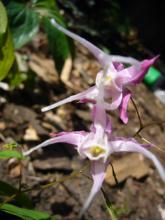
E.omeiense 'Akame'
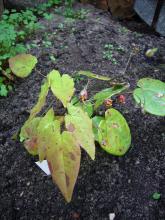
E.omeiense 'Stormcloud' (i like it so much)
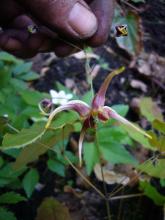
E.Seedling
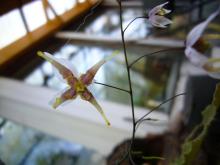
E.Seedling
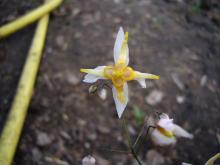
E.stellulatum 'Wudang Star' (where is the difference to the long leave form??? is it a big difference?)
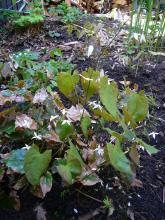
E.sutchuense
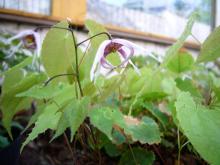
E.'William T Stearn'
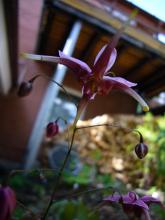
and two pictures of my mosted loved E.grandiflorum
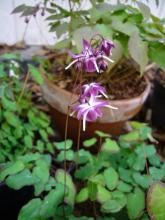
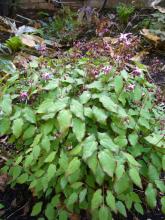
'Freya' also called 'Nanum Violaceum'
And an other question from me: Why do some Epimedium seem not to flower this year? (for example : E.grdfl. 'Red Beauty' , E.macrosepalum)
gerrit (not verified)
Re: Epimedium 2012
Sat, 04/28/2012 - 10:44amSome great species you grow in your garden. Most of all I like E. 'Fire Dragon', a cross between 'davidii x leptorrhizum by Robin White. A super plant with two-tone flowers. Very floriferous. Lost mine during last winter by extreme frost of - 23 in a trogue.
Another fine species, E.fargesii 'Pink Constellation', a young plant, I can see. A great future for this excellent cultivar.
The 2 koreanum-types, I'm not familiar with it, so Mark will probably answer.
Another very good choose is E.gr.var.higoense 'Bandit'. Like 'Saturn' beautiful foliage and nice small white flowers. A good one for even the alpine-garden. Vulnerable because a little sunshine will damage or destroy the plant.
A surprise which occurred last week, the GVE catalogue arrived with a lot of new species and cultivars, but not for us Ernie. Prices and shipping are to expensive. So we can only dream of it.
gerrit (not verified)
Re: Epimedium 2012
Sat, 04/28/2012 - 10:53amYour last question about flowering this year. I could asked the same question to you. Flowering on my E. this year is very irregular. I presume, due to the extreme weather conditions. !n March it was very hot. A Row of many days with temps of 20 degrees, so the plants developed stems with flowers to soon. After that a period with cold arrived a the development of flowers stopped.
gerrit (not verified)
Re: Epimedium 2012
Sat, 04/28/2012 - 11:20amFreya is a beautiful cultivar, you are definitely Wright. Deep purple flowers.
And William Stearn, a superb Epimedium.
About stellulatum 'Wudang Star'. The difference you can see in the 'long leaves' indeed.
Stormcloud, almost brown flowers. A rare colour. I like it very much as you do indeed.
ErnieC123 (not verified)
Re: Epimedium 2012
Sat, 04/28/2012 - 11:22amAnd weather is getting more worth next week for our Epimedium! Too hot for a long flower! I get disapointed now!
But i have forgoten E.wushanense nova
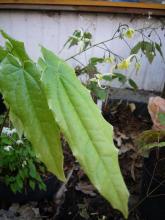
I like this one and enjoy it all day!
Trond Hoy
Re: Epimedium 2012
Sat, 04/28/2012 - 1:34pmI like them all! But if I should choose one, I would take E. fargesii! (Excuses to the others.)
I can't understand why Epimediums are so hard to get in Norway.
WimB (not verified)
Re: Epimedium 2012
Sun, 04/29/2012 - 7:06amFirst some comments, then some pictures ;)
Mark,
I love your 'Bandit-hybrid', it's a lot better than 'Bandit' or 'Saturn'. (Btw Gerrit, 'Bandit' and 'Saturn' are quite easy over here, pics to follow, they aren't in flower yet!)
'Circe' is a superb cultivar. Daniëlle has it in her garden since last year...and it was to first one to catch my eye when I entered her nursery last week!
Gerrit,
I especially like your Japanese hybrids. 'Togen' and 'Ko Zakura' are stunning!
Ernie,
I love your E. acuminatum and 'Stormcloud'. I had never heard of E. grandiflorum 'Creeping Yellow' before...it looks to be a very pale yellow!
I've never seen a real Epimedium pallidum, all the one's I've ever seen, turned out to be E. x versicolor 'Sulphureum'. I hope you have the real one!
WimB (not verified)
Re: Epimedium 2012
Sun, 04/29/2012 - 7:15amAnd now some pics, as promised:
Epimedium 'Akebono'
Epimedium 'Beni-Kujaku'
Epimedium grandiflorum 'Akagi Zakura'
Epimedium grandiflorum 'Freya'
Epimedium grandiflorum 'Lilafee'
Epimedium 'Hagoromo'
Epimedium 'Spine Tingler'
Epimedium x youngianum 'Hana Guruma'
Mark McDonough
Re: Epimedium 2012
Sun, 04/29/2012 - 7:38amHello fellow epimedium fans; much has been posted, the epimediums are looking superb, much to respond to. But I promised myself on this fabulous crisp sunny day, I will tear myself away from the forum and the processing of hundreds of photos, to go work in the garden instead. But before I head out to the garden, I wanted to take a moment to comment on an ID.
Gerrit, I believe there might be a mixup in the one labeled as E. x youngianum 'Kozakura'. I believe the plant you show is actually E. x youngianum 'Beni-Kujaku' (Wim shows a photo of this). I am posting two photos of each variety to compare. Kozakura is an odd one, with deciduous sepals and little open cups of pale lavender with the middle of each petal stained a deeper lavender-pink. It's not very showy, more of a curiosity. It's in flower now (photos taken today), whereas E. youngianum 'Beni-Kujaku' is one of the earliest to flower (well, at least here that's the case), fairly showy with lots of deep red-violet flowers, until the quick-to-appear second flush of leaves overtakes the flowers.
E. x youngianum 'Kozakura'
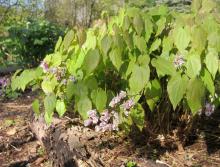
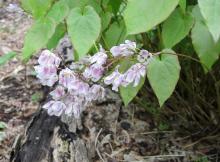
E. x youngianum 'Beni-Kujaku'
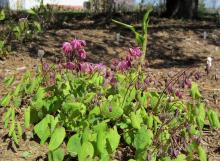
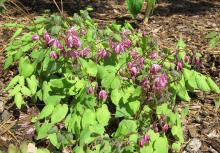
Love the E. stellulatum 'Long Leaf Form', I have put this one in my order to Garden Vision Epimediums; I currently have the regular form and it's a favorite. More later :)
WimB (not verified)
Re: Epimedium 2012
Sun, 04/29/2012 - 9:19amVery nice, that 'Ko Zakura', Mark...maybe I should buy that one too!
Mark McDonough
Re: Epimedium 2012
Sun, 04/29/2012 - 10:16amWim, where does one find the correct syntax of a Japanese cultivar name? Everywhere I have looked, including the RHS Plant Finder, the cultivar name is listed simply as 'Kozakura', I have not seen it as 'Ko Zakura'. Is there a reference for how the cultivar was first described? Googling, it seems that 'Kozakura' is a Japanese surname. Just curious, as I'm a stickler for details :)
http://apps.rhs.org.uk/rhsplantfinder/plantlist.asp?code=XPou+&name=Koen...
WimB (not verified)
Re: Epimedium 2012
Sun, 04/29/2012 - 10:23amI always separate the words according to their meaning: Ko = Child; Zakura or Sakura = Cherry Blossom....I'm not sure if that is how it should be separated, but that's how my Japanese friends showed me the meaning of cultivar names when I was writing my article on Japanese Adonis.
ErnieC123 (not verified)
Re: Epimedium 2012
Sun, 04/29/2012 - 2:02pmCan somebody help me with these two Epimedium grdfl.ssp.koreanum? Maybe one is E.gdfl.ssp.flavescens?
Thank you before answering :-)
gerrit (not verified)
Re: Epimedium 2012
Sun, 04/29/2012 - 2:06pmThank you Mark. You are definitely wright. This is not E.x youngianum 'Kozakura' indeed. Glad you noticed it.
Kozakura is a curiosity and I will buy it as soon as possible. I like it very much.
Richard T. Rodich
Re: Epimedium 2012
Sun, 04/29/2012 - 4:59pmI like them, every one.
But Wim, Spine Tingler is magical! And the photo is truly fantastic! :o
Mark McDonough
Re: Epimedium 2012
Sun, 04/29/2012 - 8:13pmMuch to catch up with:
Ernie, great to see 'Fire Dragon', this is a new one in my garden too, just starting to flower and I'm excited to see the excellent color of the flowers.
Regarding the two epimediums in question, your first E. grandiflorum koreanum is actually E. grandiflorum f. flavescens. The other one, with large light yellow flowers low on the stem with foliage high above, is E. koreanum. The species separation between E. grandiflorum f. flavescens and E. koreanum is cited in William Stearn's monograph on Epimedium.
E. grandiflorum 'Creeping Yellow' is an unfortunate name; from researching this one, it is a very nice foliage plant, the name referring to the light chartreuse green foliage that is banded with red and specked red; the flowers reported by numerous nurseries as pure white.
E. myrianthum does indeed have spectacular mottled spring foliage, I like these types of "eppies". Never heard of E. grandiflorum 'Kotobuki', seems to be so many subtlely different Japanese cultivars. Here's a web site with many Japanese cultivars, many I have not heard of.
http://www.shikoku-garden.com/lists/List2009/Epimedium09.htm
Wish that I could find E. grandiflorum 'Freya' here, looks like a real winner.
Gerrit, I have no problem with E. grandiflorum v. higoense, and varieties 'Bandit' and 'Saturn' with lots of strong light. In the Garden Vision Epimedium nursery, these received almost full sun, and did just fine, as do mine.
Wim, E. grandiflorum 'Akagi Zakura' is gorgoeus, a delicious red-pink color, and low stature. Not heard of this one before.
Regarding E. "pallidum", there is no such published name, no such species, it is a horticultural misnomer.
WimB (not verified)
Re: Epimedium 2012
Mon, 04/30/2012 - 12:32amShikoku has a very nice website....it's one of the few Japanese nurseries which exports:
Some more Japanese Epimedium pictures, here:
http://www7b.biglobe.ne.jp/~yamakusa/newpage9.htm (if you click the pictures, they enlarge!)
http://www7b.biglobe.ne.jp/~yamakusa
http://www.ishidaseikaen.com/webshop/products/list326.html
ErnieC123 (not verified)
Re: Epimedium 2012
Mon, 04/30/2012 - 12:44pm'Fire Dragon' is a real nice cultivar but it looses its color when getting to warm!
I would like to send you a E. grdfl. 'Freya', but i don't know what i have to do. Clear of all soil is a must so it works only in winter. Do i have to put a plant certification into the mail? If it is easy , i would send you one plant. In summer a friend of my brother from the usa visits us in germany. Maybe she can take a plant to the usa. I will ask duty officers if there is a possibility.
I heard about E.pallidum that Ernst Pagels has selected this plant. He was a a student of Karl Foerster. Pagels breaded mostly grasses like Miscanthus. But he also breaded Sedum, Salvia, Achillea, Aconitum and other. Maybe he found a seedling next to E.vers.'Sulphureum' or other. He only registered about 140 plants of many selections he made. So this might be the problem. I will plant a E.vers.'Sulphureum' next to my E.pallidum and try to find a difference.
And i just wanna say thanks a lot mark for bringing light into the dark!!! Now i know what E.koreanum and E.grdfl.v.flavescens is!
Mark McDonough
Re: Epimedium 2012
Mon, 04/30/2012 - 7:32pmErnie, no need to attempt sending plants here. The person receiving plants here in the USA, originating from another country, can be heavily fined if all the proper required certificates are not in place. It's too hard to send plants internationally, the USA restrictions are many, so please don't attempt it, although I certainly appreciate your most generous offer.
Regarding E. pallidum, the problem comes from the fact it is named as a species, not a cultivar like 'Pallidum' (which in itself is invalid to name culivars with latinised names), but the botanical binomial Epimedium "pallidum" was never a published name, it appears to be a horticultural invention that only occurs in horticulture, not in botanical science. There are many examples of phantom names that only exist in the nursery trade. I still believe there is no such thing as true Epimedium "pallidum", but of course, some nurseries will offer a plant named E. pallidum
Mark McDonough
Re: Epimedium 2012
Mon, 04/30/2012 - 7:41pmMoreso than ever, I'm moving towards epimediums as supreme foliage plants. Yes, I do love the delicate airiness of epimedium flowers, but the leaf forms, colors, and "leaf-build" (the way the leaves stack up), provide compelling attraction season long, all year long with evergreen species. This series of 10 photos focuses on epimedium foliage and plant views.
1. E. brachyrrhizum showing a lush second flush of lively bullate glossy foliage, the 2nd year evergreen foliage visible at the base. On my top 10 list, for gorgeous sprays of silvery pink flowers and year-round great foliage.
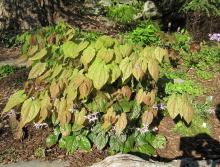
2. E. brevicornu clump, another wider-than-tall cornerstone species that should be in every garden, with Corydalis nobilis in the background.
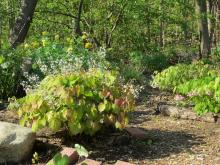
3. E. sempervirens - MMcDonough selected hybrid. Wow, this one is really paying off, been watching this one for 5 years. I will be showing a spring foliage progression to show the foliar metamorphosis, the early foliage is dark chocolate color, now making a high rounded dome of layered shiny green, red-edged leaves.
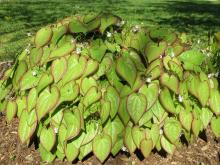
4. E. grandiflorum 'Princess Susan', the standard by which to compare bright two-toned grandiflorums by, one of the best. The flowers peak out at the periphery of a flat-topped leafy plateau.
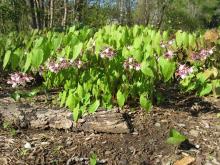
5+6 E. membranaceum x ?stellulatum - I have a number of these. Originally I identified these as membranaceum x brevicornu, based on the fact the seedlings were found under these two species which were growing intertwined. However, the bright orange new growth suggests stellulatum as a parent instead, growing about 3' away (bees do fly). The foliage is the main attraction, and the fact the small white and yellow flowers keep on going until the end of August (everblooming characteristic from membranaceum). In the foreground is E. youngianum 'Grape Fizz', a pleasant cultivar.
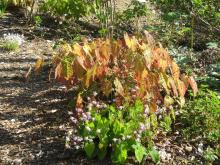
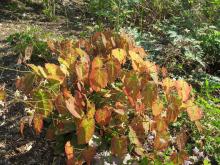
7. The epimedium garden viewed in morning sunlight has special moments. Here we see E. x youngianum 'Sudama' aglow with morning light. More about this unusual cultivar with ceropegia-like flowers that never open.
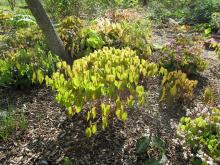
8. In the center right is Epimedium pubescens 'Shaanxi Form'. It is early to emerge and was whacked by a very hard frost, the stems and leaf growth hanging limp, but it has recovered. I've been adding pieces of Bluets, Houstonia caerulea to line the paths, and they quickly bulk up into wonderful clumps that flowers for months.
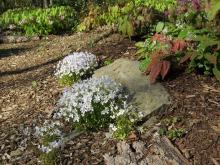
9. Here we see another putative E. membranaceum x ?stellulatum hybrid, this one smaller growing. The lime green leaves behind it is E. pubescens, a newish form offered by Garden Vision Epimediums that is said to be partially creeping rather than clumping.
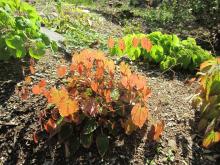
10. E. x versicolor 'Cupreum' - this plant is ancient, maybe 35 years old, and it remains an favorite with mahogany red heart foliage, each leaf with a network of green. The coppery-pink flowers are a real attraction too.
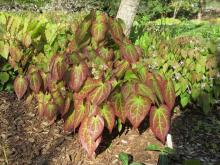
gerrit (not verified)
Re: Epimedium 2012
Tue, 05/01/2012 - 10:43amWonderful pictures. You have given us moments of joy watching those lovely plants, especially walking through the morning light. Thanks for sharing this with us.
gerrit (not verified)
Re: Epimedium 2012
Tue, 05/01/2012 - 10:58amWhat you see is a form of Epimedium davidii. Bought under the registrationnumber EMR 4125.
It is an odd one. Only cups, almost no spurs. I love my plant, because it's a curiosity.
Please readers, comment on it.
WimB (not verified)
Re: Epimedium 2012
Tue, 05/01/2012 - 11:10amOne of Martin Rix's findlings....it's a very beautiful form, but I'm biased since I like all E. davidii!
gerrit (not verified)
Re: Epimedium 2012
Wed, 05/02/2012 - 10:04amToday 2 members of the x omeiense family.
1. Epimedium x omeiense 'Stormcloud'. Mysterious coloured flowers like a stormcloud indeed.
2. Epimedium x omeiense 'Myriad Years'. Long stems, hanging down.
3. The same plant. That's me, lifting up the long stem, so you can look at the flowers.
Mark McDonough
Re: Epimedium 2012
Wed, 05/02/2012 - 10:44amE. davidii EMR of my Favs too Gerrit; your plant looks like it is growing more robust than mine. I also like it because it keeps sending up sprays of flowers, almost all of which I steal to dab pollen on other eppies ;)
Your Epimedium x omeiense 'Myriad Years' brings myriad tears to my eyes, what a beauty it is, don't think it is available here in the USA, will have to look :o
ErnieC123 (not verified)
Re: Epimedium 2012
Wed, 05/02/2012 - 12:42pmEnjoy my seedling with me :-)
gerrit (not verified)
Re: Epimedium 2012
Thu, 05/03/2012 - 4:14amI enjoyed your seedling very much. It is a cute thing.,whatever it is. Wonderful two-tone colour. Would you be so kind and try to separate the plant in the fall and send me a part of it. Of course I'll pay the shipping costs.
Mark McDonough
Re: Epimedium 2012
Thu, 05/03/2012 - 7:08pmI agree Gerrit... Ernie that's a very bright color seedling, very nice, it's such fun finding your own seedlings. After spending lots of money over the past 10 years buying very expensive epimediums building up a collection of about 200 species and hybrids, I can now rejoice in filling my garden with numerous spontaneous or manually created hybrids, many of which are equally bright and enjoyable, some even better and certainly unique, and at 0$ cost ;D
gerrit (not verified)
Re: Epimedium 2012
Fri, 05/04/2012 - 6:46amI like to show 2 epi's looking a bit the same, the flowers anyway.
1 and 2. Epimedium 'Pink Elf', leptorrhizum x pubescens, Robin White.
3 . Epimedium 'Domino'.
ErnieC123 (not verified)
Re: Epimedium 2012
Fri, 05/04/2012 - 12:33pmThanks Gerrit and Mark! I like the seedling too. Haven't you recognize the five petals??? Thats what enjoys me the most.
Gerrit i don't want to promise , but i keep you in mind for a division of the clone. Your 'Domino' is awesome, mine doesn't flower yet:-( But i think flowers will open next week. My 'Amber Queen' is even smaller and waits for growing.
I am totaly addicted to Epimedium today because my E.latisepalum flowers now. It is a real beauty. I will take a picture!
gerrit (not verified)
Re: Epimedium 2012
Fri, 05/04/2012 - 1:46pmYes, funny. Only a singel flower does this? A disfigurement like my davidii.
ErnieC123 (not verified)
Re: Epimedium 2012
Sat, 05/05/2012 - 8:12amIt is just the one flower.But i pollinated it, in the hope of something beautiful
You said it looks like the 'Pink Elf' or 'Domino', i don't think so.
The habitus looks much more like a E.grandiflorum-hybrid. I have an eye on that cultivar:-)
gerrit (not verified)
Re: Epimedium 2012
Sat, 05/05/2012 - 1:17pmSorry Ernie, I didn't make myself clear. I compared 'Pink Elf' with 'Domino'. Not with your seedling.
gerrit (not verified)
Re: Epimedium 2012
Tue, 05/08/2012 - 12:50amTwo representifs from the species acuminatum.
1 and 2 Epimedium acuminatum
3 and 4 Epimedium acuminatum 'Night Mistress'.
First photo the whole plant, second the flowers.
You may compare the difference between the species and the cultivar. The cultivar with bigger and brighter flowers.
gerrit (not verified)
Re: Epimedium 2012
Thu, 05/10/2012 - 9:53amEpimedium 'Spine Tingler', a cultivar with extraordinary spiny leaves, like a spine indeed. The flowers, very small in size. A good one for the rock garden. I like this one very much.
WimB (not verified)
Re: Epimedium 2012
Thu, 05/10/2012 - 11:06pmA very nice new Japanese form: http://sainohana.cocolog-nifty.com/photos/uncategorized/2012/05/10/img_3...
Or this one: http://sainohana.cocolog-nifty.com/photos/uncategorized/2012/04/21/img_2...
What do you think?
You can see more on the blog: http://sainohana.cocolog-nifty.com/blog/2012/05/index.html
Mark McDonough
Re: Epimedium 2012
Fri, 05/11/2012 - 5:04amGerrit, when I see you images of the acuminatum forms, and 'Spine Tingler', I am reminded of the expression "so close, yet so far away", by that I mean, I'm so close to the epicenter of Epimediums (Garden Vision Epimediums nursery), yet the dramatic 'Night Mistress" was only offered for a short time in the Garden Vision Nursery, and very high price too, so I didn't buy it, which I now regret as it hasn't been available for years. Same with 'Spine Tingler', which is still very high priced, so it is another that I do not have; a fascinating unnamed species. Visiting Garden Vision last weekend, I bought regular E. acuminatum, a replacement for the species that I lost a number of years ago. :)
Wim, glad you showed that link to a dramatic color break, a pure red and white bicolor Epimedium, truly something different, nice flower form too. Thanks for sharing this blog link. I took a peak at another month's entry of the same blog, check out the stunning Arisaema selections and Epimedium hybrids. I supply the direct link (Japanese text) and a Bing-translated version.
http://sainohana.cocolog-nifty.com/blog/2012/04/index.html
...bing translation version:
http://www.microsofttranslator.com/BV.aspx?ref=IE8Activity&a=http%3A%2F%2Fsainohana.cocolog-nifty.com%2Fblog%2F2012%2F04%2Findex.html
Mark McDonough
Re: Epimedium 2012
Fri, 05/11/2012 - 5:15amI have so many Epimedium photos taken in the last few weeks, but barely enough time to show many of them. I also want to show photos from my visit to Garden Vision Epimediums last weekend during an "open nursery weekened"; these are now held at Karen Perkins charming rural location in Templeton Massachusetts (central MA). But, the next 2-1/2 weeks I'll be traveling a great deal, and will probably not have time to post much. So, today I post a random pair of images, Epimedium x versicolor 'Strawberry Blush', one of the more recent Garden Vision introductions.
Side by side portraits of the delicate hued blooms, one in indirect light and the other catching sunlight. The flowers are a very soft shade of peach-pink, with a lemon cup, these colors only visible when lifting the flowers, from above the broad-rounded sepals are a soft moonlight yellow color. The spring foliage is intense copper color.
gerrit (not verified)
Re: Epimedium 2012
Sat, 05/12/2012 - 12:49amLast week I had the opportunity to see Epimedium x versicolor 'Strawberry Blush' in real. It was a special experience. This an extraordinary cultivar. Relatively large flowers with no spikes with soft colours, especially lightened when hit by the sunlight. The name, strawberry, is a good choose. And not to forget the foliage, copper-like bronze, the same what we see in E.x versicolor 'Versicolor'.
This cultivar is not available in The Netherlands and will not. To bad, in a globalized world. There is, as in the past, an 'iron curtain' between North America and Europe.
Mark, I'm looking forward to your pictures, visiting GVE last week and your garden photos. There are not many people looking at, but be sure, on the other side of the ocean, some are waiting for it.
Beside, hopefully is your travelling for fun and not for work. ;D ;D
gerrit (not verified)
Re: Epimedium 2012
Sat, 05/12/2012 - 9:04amA beautiful display: Epimedium grandiflorum 'Yellow Princess', Corydalis kashmiriana and Arisaema griffithii
Mark McDonough
Re: Epimedium 2012
Sat, 05/12/2012 - 5:31pmGerrit, glad you showed Epimedium grandiflorum 'Yellow Princess', I was away for two days (my daughter's college graduation), and just got home tonight, and this very late-emerging-late-flowering alpine selection of E. grandiflorum was just opening its first flowers. It is a good partner with E. grandiflorum 'Cranberry Sparkle', another late-emerging-late-flowering alpine selection with first flowers just showing upon my return home. The latter has about the deepest red-violet flowers of any epimedium. I post a photo taken at Garden Vision Nursery last week, where their plants are ahead of mine, and looking great in early bloom. Notice that neighboring Epimedium are in full leafage, some finished flowering, and this one is just emerging and beginning to flower, adding a month extension to the Epimedium season.
Traveling... unfortunately it is all for work.
gerrit (not verified)
Re: Epimedium 2012
Sun, 05/13/2012 - 3:10amThat's the good news. A very important event, congratulations, Mark. What 's she gonna do after this?
Okay, that's the bad news, but when you are alone in your hotelroom, with nothing to do, you may take your note book and watch the pages of our beautiful VRV-forum, particularly the Epimedium thread 2011 and maybe you will make an account and participate on the forum.
Pages